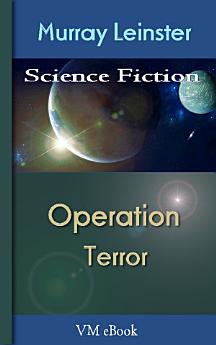Operation Terror: Leinster'S Science Fiction
About this ebook
On the morning the radar reported something odd out in space, Lockley awoke at about twenty minutes to eight. That was usual. He'd slept in a sleeping bag on a mountain-flank with other mountains all around. That was not unprecedented. He was there to make a base line measurement for a detailed map of the Boulder Lake National Park, whose facilities were now being built. Measuring a base line, even with the newest of electronic apparatus, was more or less a commonplace job for Lockley.
This morning, though, he woke and realized gloomily that he'd dreamed about Jill Holmes again, which was becoming a habit he ought to break. He'd only met her four times and she was going to marry somebody else. He had to stop.
He stirred, preparatory to getting up. At the same moment, certain things were happening in places far away from him. As yet, no unusual object in space had been observed. That would come later. But far away up at the Alaskan radar complex a man on duty watch was relieved by another. The relief man took over the monitoring of the giant, football-field-sized radar antenna that recorded its detections on magnetic tape. It happened that on this particular morning only one other radar watched the skies along a long stretch of the Pacific Coast. There was the Alaskan installation, and the other was in Oregon. It was extremely unusual for only those two to be operating. The people who knew about it, or most of them, thought that official orders had somehow gone astray. Where the orders were issued, nothing out of the ordinary appeared. All was normal, for example, in the Military Information Center in Denver. The Survey saw nothing unusual in Lockley's being at his post, and other men at places corresponding to his in the area which was to become Boulder Lake National Park. It also seemed perfectly natural that there should be bulldozer operators, surveyors, steelworkers, concrete men and so on, all comfortably at breakfast in the construction camp for the project. Everything seemed normal everywhere....
Ratings and reviews
About the author
Murray Leinster (June 16, 1896 – June 8, 1975) was a nom de plume of William Fitzgerald Jenkins, an award-winning American writer of science fiction and alternate history. He wrote and published more than 1,500 short stories and articles, 14 movie scripts, and hundreds of radio scripts and television plays.
Leinster was born in Norfolk, Virginia, the son of George B. Jenkins and Mary L. Jenkins. His father was an accountant. Although both parents were born in Virginia, the family lived in Manhattan in 1910, according to the 1910 Federal Census.
He began his career as a freelance writer before World War I; he was two months short of his 20th birthday when his first story, "The Foreigner", appeared in the May 1916 issue of H. L. Mencken's literary magazine The Smart Set. Over the next three years, Leinster published ten more stories in the magazine. During and after World War I, he began appearing in pulp magazines like Argosy, Snappy Stories, and Breezy Stories. He continued to appear regularly in Argosy into the 1950s. When the pulp magazines began to diversify into particular genres in the 1920s, Leinster followed suit, selling jungle stories to Danger Trails, westerns to West and Cowboy Stories, detective stories to Black Mask and Mystery Stories, horror stories to Weird Tales, and even romance stories to Love Story Magazine under the pen name Louisa Carter Lee.
Leinster's first science fiction story, "The Runaway Skyscraper", appeared in the February 22, 1919 issue of Argosy, and was reprinted in the June 1926 issue of Hugo Gernsback's first science fiction magazine, Amazing Stories. In the 1930s, he published several science fiction stories and serials in Amazing and Astounding Stories (the first issue of Astounding included his story "Tanks"). He continued to appear frequently in other genre pulps such as Detective Fiction Weekly and Smashing Western, as well as Collier's Weekly beginning in 1936 and Esquire starting in 1939.
Leinster is credited with the invention of parallel universe stories. Four years before Jack Williamson's The Legion of Time came out, Leinster published his "Sidewise in Time" in the June 1934 issue of Astounding. Leinster's vision of extraordinary oscillations in time ('sidewise in time') had a long-term impact on other authors, for example Isaac Asimov's "Living Space", "The Red Queen's Race", and The End of Eternity.









